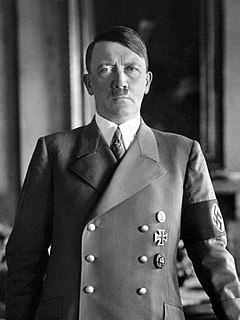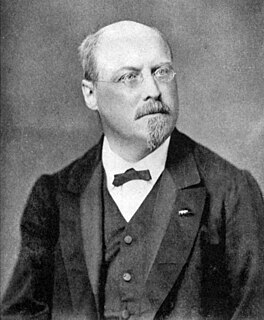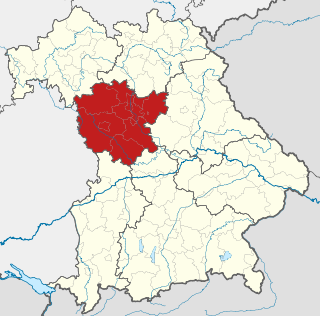Alban Schachleiter | |
|---|---|
| Born | 20 January 1861 |
| Died | 20 June 1937 (aged 76) |
Alban Schachleiter (20 January 1861 – 20 June 1937) was a Roman Catholic Benedictine monk and musicologist. He was closely associated with the Nazis, and with Adolf Hitler personally.

Adolf Hitler was a German politician and leader of the Nazi Party. He rose to power as Chancellor of Germany in 1933 and later Führer in 1934. During his dictatorship from 1933 to 1945, he initiated World War II in Europe by invading Poland in September 1939. He was closely involved in military operations throughout the war and was central to the perpetration of the Holocaust.
Schachleiter first became closely associated with the NSDAP, and with Hitler, in late 1922. Originally from Mainz, he served as the long-time abbot of the Emmaus monastery in Prague before being forced out of that position in late 1918 following the establishment of the new Czechoslovak state.[ citation needed ] After brief stays at several Austrian monasteries, including St. Florian near Linz, by early 1920 he was at Munich's St. Boniface's Abbey. By September 1922 he was noticed for the radicalism of his anti-Semitic agitation and his involvement with groups like the volkisch Bund Bayern und Reich. He cultivated connections with members of Munich's Catholic elite, including w:de:Karl Alexander von Müller, professor of history at the University of Munich, and Helene Raff, whose father was the composer Joachim Raff. With Muller he discussed politics and Gregorian chant. Through these connections he first met Hitler in late 1922; the pair were observed by both Muller and Ernst Hanfstaengl engaging in lively and lengthy conversation. It was the beginning of a relationship that ended only with Schachleiter's death in 1937. The meeting opened the way for Schachleiter to play an important propagandist role on behalf of the NSDAP in the summer of 1923.

Linz is the third-largest city of Austria and capital of the state of Upper Austria. It is in the north centre of Austria, approximately 30 kilometres south of the Czech border, on both sides of the River Danube. The population of the city is 204,846, and that of the Greater Linz conurbation is about 789,811.

Joseph Joachim Raff was a German-Swiss composer, teacher and pianist.
Following the commemorative activities of 10 June 1923—which included a massive rally in honour of Albert Leo Schlageter, staged on Munich's Konigsplatz and attended by 20-30000 activists—a Catholic memorial Mass was held immediately after the rally in St. Boniface Abbey, organised exclusively by the NSDAP, which was presided over by Schachleiter. Hanfstaengl had sketched out for Hitler the symbolic impact a related Catholic-Nazi Mass for Schlagater would have on Munich's Catholic population—Schachleiter could also consecrate the standards of the SA. Hitler quickly agreed. Schachleiter delivered a eulogistic sermon that was remembered as having a powerful impact—a young and devoutly pious Heinrich Himmler joined the NSDAP in the wake of Schachleiters eulogy. [1]

Albert Leo Schlageter was a member of the German Freikorps. His activities sabotaging French occupying troops after World War I led to his arrest and eventual execution by French forces. His way of death fostered an aura of martyrdom around him, which was cultivated by German nationalist groups, in particular the Nazi Party. During the Third Reich, he was widely commemorated as a national hero.

Königsplatz is a square in Munich, Germany. Built in the style of European Neoclassicism in the 19th century, it is a center of cultural life. The area around Königsplatz is today the home to the Kunstareal, Munich's gallery and museum quarter.

The Sturmabteilung, literally Storm Detachment, was the Nazi Party's original paramilitary. It played a significant role in Adolf Hitler's rise to power in the 1920s and 1930s. Its primary purposes were providing protection for Nazi rallies and assemblies, disrupting the meetings of opposing parties, fighting against the paramilitary units of the opposing parties, especially the Red Front Fighters League of the Communist Party of Germany (KPD), and intimidating Romanis, trade unionists, and, especially, Jews – for instance, during the Nazi boycott of Jewish businesses.
A year later however, Schachleiter was writing to Oswald Spengler lamenting the impact of Erich Ludendorff and his anti-Catholic followers on the movement: following the refounding of the NSDAP in early 1925 the stronghold of the Nazi movement in Bavaria would no longer be Munich but rather the Protestant regions of Mittel- and Oberfranken. Schachleiter increasingly distanced himself from the NSDAP in the mid-1920s, although he maintained an idealised image of Hitler personally.

Oswald Arnold Gottfried Spengler was a German historian and philosopher of history whose interests included mathematics, science, and art. He is best known for his book The Decline of the West, published in 1918 and 1922, covering all of world history. Spengler's model of history postulates that any culture is a superorganism with a limited and predictable lifespan.

Erich Friedrich Wilhelm Ludendorff was a German general, the victor of the Battle of Liège and the Battle of Tannenberg. From August 1916, his appointment as Quartermaster general made him the leader of the German war efforts during World War I. The failure of Germany's great Spring Offensive in 1918 in its quest for total victory was his great strategic failure and he was forced out in October 1918.

Middle Franconia is one of the three administrative regions of Franconia in Bavaria, Germany. It is located in the west of Bavaria and borders the state of Baden-Württemberg. The administrative seat is Ansbach, however the most populous city is Nuremberg.
Schachleiter continued for years to be angry at Ludendorff's anti-Catholic crusade following the putsch of November 1923. After maintaining his weekly Schola Gregoriana at the Allerheiligen-Hofkirche in Munich until 1930, he then moved to a newly built country house in Bad Feilnbach where he was still living when Hitler came to power in 1933. In late spring Schachleiter wrote to Cardinal Faulhaber: "It seems to me to be a catastrophe that the Holy Church stands aloof from the new freedom movement, whose triumph I foresaw, and that the massive uprising of the volk, which is now lifting our poor fatherland out of its misery and shame, may well go down in history as a triumph of Protestantism." [2] Faulhaber forbade Schachleiter from performing Masses within the archdiocese, and Schachleiter reluctantly refused Hitler's request for him to come to Berlin on 20 March 1933 to perform a personal Mass for the fuhrer. Hitler visited in mid-May to personally congratulate Schachleiter on his 50th anniversary as a Benedictine. His invitation to sit among the Nazi dignitaries at the Nuremberg party rally in 1934, which he accepted, (and an enduring image through Leni Riefenstahl's Triumph of the Will ), showed him "on the sidelines as the Nazis' striking, yet thoroughly secularized, performative aesthetic played out before him." [3]

The Allerheiligen-Hofkirche is a church in the Munich Residenz designed by Leo von Klenze and built between 1826 and 1837. The church was badly damaged from bombing during World War II and for decades remained a ruin before undergoing partial restoration and secularization. It is now used for concerts and events.

Michael von Faulhaber was a Catholic Cardinal and Archbishop of Munich for 35 years, from 1917 to his death in 1952. Faulhaber was an opponent of the Nazi government and considered Nazi ideology incompatible with Christianity; but he also rejected the Weimar Republic as rooted in treason and opposed democratic government in general, favoring a Catholic monarchy. Faulhaber spoke out against some Nazi policies, but publicly recognized the Nazi government as legitimate, required Catholic clergy to remain loyal to the Nazi government, and maintained bridges between fascism and the Church. He ordained Joseph Ratzinger as a priest in 1951, and was the last surviving Cardinal appointed by Pope Benedict XV.

Protestantism is the second largest form of Christianity with collectively between 800 million and more than 900 million adherents worldwide or nearly 40% of all Christians. It originated with the 16th century Reformation, a movement against what its followers perceived to be errors in the Roman Catholic Church. Protestants reject the Roman Catholic doctrine of papal supremacy and sacraments, but disagree among themselves regarding the real presence of Christ in the Eucharist. They emphasize the priesthood of all believers, justification by faith alone rather than by good works, and the highest authority of the Bible alone in faith and morals. The "five solae" summarise basic theological differences in opposition to the Roman Catholic Church.
From 1933-1936 Schachleiter spent much energy campaigning against what he saw as peripheral Nazi personalities directing the Nazis in an anti-Catholic and anti-Christian direction—and particularly the ideology advanced by Alfred Rosenberg. Schachleiter regarded this as a restraint on a renewal of wide-ranging Catholic support for the NSDAP. Schachleiter eventually wrote more than two dozen appeals to a variety of Nazi officials, including Hans Lammers, but was ignored. In September 1936 he admitted privately to a friend that, "a believing Christian can no longer participate [in the NSDAP]; they do not want believing Christians in the party." Publicly he continued to profess loyalty to the Führer and to the church. [4]

Alfred Ernst Rosenberg was a Baltic German-born theorist and an influential ideologue of the Nazi Party. Rosenberg was first introduced to Adolf Hitler by Dietrich Eckart and later held several important posts in the Nazi government.

Hans Heinrich Lammers was a German jurist and prominent Nazi politician. From 1933 until 1945 he served as Chief of the Reich Chancellery under Adolf Hitler. During the 1948–1949 Ministries Trial, Lammers was found guilty of war crimes and crimes against humanity and sentenced to 20 years' imprisonment.
Following his death in June 1937 the Nazis ordered a state funeral arranged by Bavarian minister-president Ludwig Siebert. A year later the editorial leadership of the Beobachter refused attempts to publish official commemorations. According to historian Derek Hastings, by 1937 Schachleiter's vision of a renewed Catholic-Nazi synthesis had become increasingly marginal.















